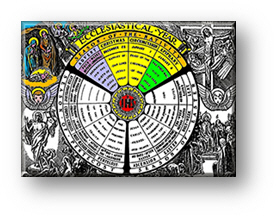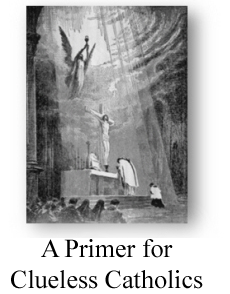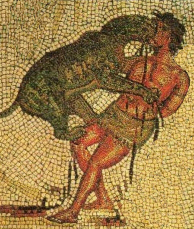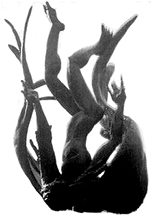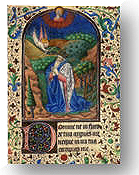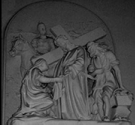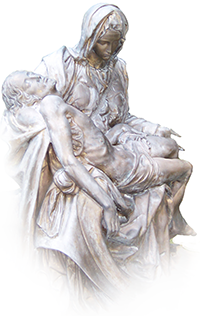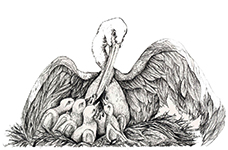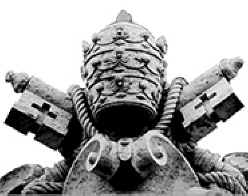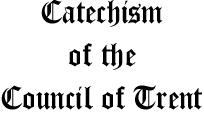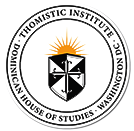|
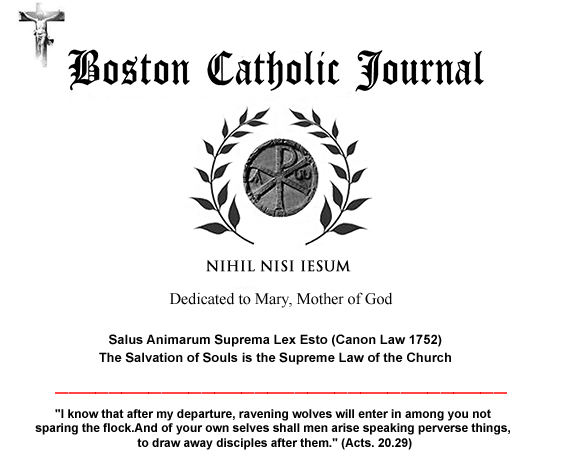
A BIOGRAPHY OF SAINT JOHN
OF THE CROSS,
CONFESSOR, Doctor of the Church
by:
Geoffrey K. Mondello
The culmination
of every Christian life is the attainment of holiness
Sanctity,
I think, is often so compelling that we are loath to subject it to any
association with error. We are inclined, in effect, to extrapolate from
sanctity to inerrancy, as the though a defect in the latter vitiates
the former, which is not at all the case. Christ’s stinging rebuke to
Peter is a sober reminder of this. 1
But the fact remains
that it is likely in some to attenuate the genuine and unsparing critical
impulse necessary to the objective analysis of a Saint’s work – and
as a consequence to forfeit truth; a defection no less antagonistic
to good philosophy than to religion. Truth itself, it has been suggested,
must be esteemed as holy – and any defection from it a defection from
the very holiness toward which we strive. And this is simply another
way of saying that we cannot hope to attain to a consistent end through
inconsistent means. And while we must be careful of a susceptibility
to this type of critical latitude in dealing with the Saints, we must,
on the other hand, and quite obviously, recognize that sanctity and
critical acumen, while not allied of necessity, have quite often found
common ground in the lives of the Saints. Even the most cursory perusal
of the voluminous Patrolgiae Latinae Cursus Completus or the
Patrologiae Graecae – to mention nothing of the great multiplicity
of philosophical and theological works within the Church that extends
to the present day – clearly attests to this. And this is simply to
say, on the other hand, that sanctity no more precludes critical acumen
that critical insight precludes sanctity.
Nevertheless, it remains a common, even a persistent misconception that
a Saint’s commitment to doctrine – which, from the Catholic perspective,
is at least an integral aspect of the imputation of sanctity – precludes,
or at least impedes, hampers, confines, even compromises the disinterested
dedication to truth. But the fact of the matter is that the sanctions
incorporated into that very body of doctrine are more far-reaching,
and far more stringent, relative to a commitment to truth than those
which are selectively and subjectively appropriated outside of it according
to the individual inclination of the skeptic. This is not to disparage
the moral integrity of the skeptic, but merely to place it within existential
perspective. The historical and often heroic commitment to truth on
the part of many Catholic philosophers is, I suggest, exemplified in
a way seldom encountered by their skeptical counterparts in a given
culture– whether we consider the ancient martyrology beginning with
the early Christian philosopher St. Justin Martyr who, rather than equivocate
the truth, was scourged and beheaded in 165 AD; or in our own times,
and within the great Carmelite tradition itself, in the case of St.
Teresa Benedicta of the Cross, who as Edith Stein, the German philosopher
and colleague of the twentieth century phenomenologist Husserl, perished
at the Nazi death camp at Auschwitz in 1942, both as a Jew and a Nun,
renouncing neither and suffering for both – despised by the Nazis as
a Jew and forsaken by her family as a Catholic Nun. Both, I maintain,
are paradigms in the sense that each had clear existential alternatives,
the extreme consequences of which turned exclusively upon their uncompromising
relation to truth. These, and the many examples to which we can appeal,
evidence a commitment to truth often supremely enacted; and that commitment,
I suggest, which does not blench before the prospect of death is much
less likely to be compromised in matters decidedly less final in nature.
Of course, such commitment can be, and frequently is, dismissed, or
worse yet, trivialized as ‘fanaticism’, but I think, by and large, that
this explanation is much too convenient, for we invariably see little
of this trait, and much more in the way of balanced reason evidenced
in the lives of the Saints. We are all familiar with one account or
another in which the personality, or more specifically, perceived defects
in the personality, are held to be explanatory of the doctrine. Interpreted
psychologically in terms of a symptomatic, rather than philosophically
in terms of its intrinsic coherence, the focus shifts altogether from
philosophy (the doctrine as logical) to pathology (the doctrine as pathological).
At times this would appear to be explanatory of at least some aspects
of a given doctrine – but seldom the entire doctrine. Nietzsche, I think
stands as one example of this, and so does Schopenauer. But one will
be hard pressed to detail this type of psychological association between
St. John of the Cross and his doctrine; in effect, to see his doctrine
emerging from his personality, and not out of his experiences. Those
who would seek such an explanatory are bound to be disappointed in the
life of St.
John.
Beginnings
Born Juan de Yepes y Alvarez on what is likely the 24th of June 1542
in Fontiveros, Spain, St. John of the Cross was the youngest of three
sons born to Gonzalo de Yepes and Catalina Alvarez. John’s father, from
a proud Toledo family which had accumulated some considerable wealth,
had a bright future before him in the silk trade from which the family
fortune had been amassed, but his marriage to Catalina, who was of humble
origin, was considered by his family an unpardonable misalliance, and
Gonzalo was effectively disowned and subsequently disinherited by his
family, leaving Gonzalo with his wife and three children in great hardship.
The callous disregard of Gonzalo and his family, now reduced to poverty,
is stunning, especially in light of the untimely death of Gonzalo in
1543, two short years after the birth of John, subsequent to which the
family turned a resolutely deaf ear to the pleas of the now destitute
widow on behalf of her small children, one of whom, the second eldest,
died within a few years of Gonzalo, leaving Catalina with John and his
eldest brother Francisco. The poverty that John was later to embrace
as a religious, was cruelly thrust upon him in childhood. Catalina’s
meager earnings from silk -weaving were not enough to feed and clothe
her children who in large measure, and out of necessity, relied upon
the beneficence of a catechetical orphanage in Medina del Campo to provide
not simply the education, but the substance as well necessary to her
children. During this period, John had acquired some instruction, but
no great proficiency, in several trades with an eye toward some practical
vocation, but it was really in his youthful office as acolyte at the
Convent of Augustinian Nuns, where he served in the sacristy each morning,
and not infrequently elsewhere among other duties in the afternoon,
that John’s lifelong love of the Church very likely began. The often
long and solitary hours spent in obligations within the sacristy undoubtedly
imbued the young John with a keen sense of the sacred and an early formative
acquaintance with an atmosphere of introspective contemplation.
The Divine Summons
At sixteen, and now working at the nearby Plague Hospital de la Concepcion,
he had matriculated at the Jesuit College at Medino del Campo where
after four years of a liberal arts education, he entered the Novitiate
of the Carmelite Order in 1563 and, as was the custom, assumed a new
name, that of Juan de Santo Matia, or John of St. Matthias. Upon professing
solemn vows he undertook further study at the Carmelite College at San
Andrés which, rather auspiciously, was located at Salamanca. Here Fray
John had the opportunity to study under some of the finest minds of
late medieval Europe at the great University of Salamanca whose reputation
as a center of learning equaled, and in some respects surpassed, the
renowned medieval Universities of Paris and Oxford. Both at the College
of San Andrés and at the University of Salamanca, John had acquired
an apparently outstanding grasp of both Scholastic philosophy and theology,
and in general excelled in his studies to such a remarkable extent that,
while yet a student, he was appointed to the post of Prefect of Studies
at San Andrés. In 1567 Fray Juan de la Cruz took Holy Orders and entered
the priesthood. On the auspicious occasion of the celebration of his
first Mass, which brought him to back his hometown of Medina del Campo,
he met Madre Teresa de Jesus – better known as St. Teresa of Avila.
This acquaintance – not entirely fortuitous, for St. Teresa had sought
out the young priest who had been recommended to her as a likely candidate
to assist her in her efforts to reform the Carmelite Order at large,
friars as well as nuns – evolved into a lifelong friendship and alliance,
and was to prove momentous to both the 52 year old Carmelite Nun, and
the young 25 year old priest whose deepening spirituality and strong
sense of interiority had compelled him at this point to consider transferring
from the Carmelites to the more austere and reclusive Carthusians. But
St. Teresa in short order succeeded in persuading the diminutive but
intense young friar that his vocation lay in the white mantle that presently
stood upon his shoulders, and not elsewhere; the Order of Our Lady,
she insisted, must not be abandoned, but reformed. And she had quite
definite plans for effecting the reform which the Mitigated Rule stood
in such desperate need of, and John would be instrumental in restoring
the venerable Order to its Primitive Rule among the friars in the way
that St. Teresa had tirelessly labored to effect it among her nuns at
Valladolid. In 1568, in the company of three other Carmelite friars,
St. John changed his name at Duruelo from Juan de Santo Matia to Juan
de la Cruz – and effectively entered upon the reform of the Order. The
mutual vision and reciprocal commitment, coupled with the deep and holy
affection that bound the younger John to the older Teresa, would sustain
this collaborative effort for many years and through much hardship.
It was not long before the exemplary lives of the small community of
reformed friars and nuns that had gathered around St. John and St. Teresa
respectively began attracting vocations, and with the burgeoning reform,
in which St. Teresa had been indefatigable, it was inevitable that the
friars and nuns of the Mitigated Rule who wished to retain the individual
latitude to which they had grown accustomed should respond sometimes
acrimoniously, even violently, to the vigorous threat which the zeal
of the reform had posed. From a larger perspective, however, the ensuing
turmoil – and it was considerable – cannot be laid entirely at the feet
of St. Teresa and St. John, though neither were loath to come to terms
with the consequences of their zeal, for the call to a general reform
of all Religious Orders had been issued by the Council of Trent a year
earlier in 1568, and was already in the process of being implemented
by King Philip II in that same year – a reform, we must remember, itself
precipitated by the Counter-Reformation which had begun a mere 8 years
earlier in 1560 under the Papacy of Pius IV.
Reformatio
in Capite et in Membris:
The Counter-Reformation
Some brief overview of this period is necessary, I think, to understanding
the historical context from which the reform efforts of both Saints
took their impetus. The lax and reproachable state of affairs, especially
concerning discipline and morals, into which highly profiled segments
of the Church had fallen, had, of course, precipitated the Reformation
some years earlier, and what had been experienced by the Church on a
much larger scale had no less been the occasion of the lapse in discipline
in the religious orders in Spain as well. The formation and training
of the clergy at large had been seriously neglected in favor of the
decidedly more immediate and provincial interests of higher ecclesiastical
dignitaries and this regrettable state of affairs was often not unaccompanied
by moral turpitude. Members of the Papal Curia, no less than local bishops
and abbots, had come to understand and so exercise their authority in
increasingly secular terms, to the neglect and detriment of the primary
spiritual offices with which they were entrusted; offices which, at
least as often as not, were as instrumental to augmenting their income
as to their acquiring the perquisites of secular power. Entire cathedral
chapters, whose ecclesiastics were beneficed through endowments established
to maintain the clergy, would often spuriously combine prebends – salaries
intended to be distributed among the clergy attached to the Cathedral
– within one individual, increasing his leverage in both power and wealth.
And conditions, regrettably, fared no better with the Religious Orders
themselves. Not infrequently, monasteries of religious women were largely
congregations of the unmarried daughters of the nobility, and for many
Orders, the original charism upon which the community had been founded,
and which had provided its raison d‘être, had been entirely
lost in this lapse of orientation, or the rule so seriously mitigated
as to be unrecognizable.
A recognition of the impendence of this sorry state of affairs had existed
for some time and in fact dated at least as far back as the 14th century
where the call pro reformatio in capite et in membris
2
had begun slowly gathering the initial momentum that would culminate
in the Counter-Reformation in 1560. St. John and St. Teresa, while confining
their efforts at reform to the Carmelite order in particular, may in
fact be seen not simply as the product of the Counter-Reformation, but
as two of the most brilliant, articulate, energetic and successful figures
that the Counter-Reformation had produced. The influence of their efforts
extended well beyond the cloisters of Carmel; indeed, well beyond the
border of Spain and continues to exert itself to the present day within
the whole of Catholicism at large. In any event, the reform which the
two Saints had collaborated in effecting resulted in some particularly
bitter consequences for St. John who, taken captive by the Calced Carmelites
– the friars of the mitigated rule, who, unlike the newly reformed Discalced
Carmelites, wore sandals, the latter going barefooted, or discalced
– and refusing to renounce the reform, was subsequently imprisoned at
the Carmelite Priory in Toledo in 1577 for the better part of a year.
The room – a closet actually – that served as his cell, was a meager
6 foot by 10 foot area, unheated, unventilated, and effectively unilluminated
except for a small crevice in one wall well above the head of the spare
and diminutive friar who, standing erectly, barely attained to five
feet. Subsisting only on bread and water and an occasional sardine,
he was routinely scourged, not by one, but by every present member of
the Calced community following their evening refection and returned
to the darkness and cold – or stifling heat – of his cell. Having nothing
but the tattered clothes on his wounded and unhealing back, no breviary,
and probably most painfully, nothing with which to confect the species
through which he could celebrate Mass, St. John was left with the outer
darkness – and the gathering inner light, a combination which crystallized
in the sublime poetry that has made the works of St. John of the Cross
not just classic in Spanish literature, but among the most beautiful
poetic works ever written.
Chronology of
St. John’s Writings
After six months closely confined and in great privation, St. John was
providentially assigned a new jailer, Fray Juan de Santa Maria, who
was much more kindly disposed toward the gentle St. than his previous
incarcerator. He appears to have allowed him oil and a lamp, and more
importantly, paper and ink upon which to write, and in general seems
to have made every effort to alleviate the condition of the straitened
friar as much as was within his power to do so, despite the severe sanctions,
under provisions of the Order’s constitution, that would have been applied
against him, and with the same severity and exactitude with which St.
John himself had become intimately acquainted. At this time, St. John
composed the first thirty-one verses of his magnificent Spiritual Canticle,
and several less well-known poems. Two months later, in August of 1578,
and under circumstances deemed by some to have been miraculous, St.
John managed to escape his captors and found refuge in Toledo with the
reformed Carmelite nuns who sheltered him from his pursuers, bringing
him south to the greater safety of El Calvario in Andalusia where he
began composing the Dark Night of the Soul and the Ascent of Mount Carmel
upon which he worked sporadically until their completion in 1585.
St. John’s poetry, the magnificent and inimitable style of which contrasts
so sharply with his dense and often redundant literary treatises, is
widely considered among the most beautiful and preeminent in all of
Spanish literature to date. In fact, it is among the most beautiful,
most evocative of poetic literature in any language. As Fr. Kieran
Kavanaugh, O.C.D. correctly observes,
|
“St. John of the Cross has received the title, “the loftiest
poet of Spain”, not on
account of his books of poetry, but with some ten or twelve
compositions. These
compositions, however, display such variety that it can
almost be affirmed that each of
them represents a completely distinct poetic vision and
technique, a singular
accomplishment in Spanish literature.”
3
|
There are ten poems of indubitable authenticity, all composed within
a 14 year period preceding St. John’s death in 1591. Regrettably, none
of the original copies are extant. The copies which do exist are incorporated
into what is known as the Codex of Sanlucar, which, while not in the
hand of the Saint himself, were nevertheless unquestionably reviewed
and revised by St. John as attested to by glosses and additions to the
text which appear in the handwriting of St. John. The authenticity of
four other poems is also very likely. It is, I find, an extreme irony
– even a paradox – that one is more likely to arrive at a much clearer
intuition (not understanding) of something verging upon the experience
of unio mystica through any of these 14 poems, than through
all the protracted, carefully nuanced, and often involuted explications
which St. John offers us through the treatises we have examined in this
work. Here we have attained to consistency. In his poetry we attain
to sublimity. The poems of unquestionable authenticity are as follows:
-
Ascent
of Mount Carmel (Subida del Monte Carmelo)
-
The Dark Night of the Soul (Noche Oscura)
-
The Living Flame of Love (Llama De Amor Via)
-
The Spiritual Canticle (Cantico Espiritual)
-
I Entered in Unknowing (Yo No Supe Dόnde Entraba)
-
I Live, but Not in Myself (Vivo sin Vivir en Mi)
-
I Went Out Seeking Love (Tras de un Amoroso Lance)
-
A Lone Young Shepherd (Un Pastorcico Solo Esta Penado)
-
For I Know Well the Spring (Que Bien Sé Yo la Fuente)
-
The Romances (Romances 1-9)
-
On the Psalm: “By the Waters of Babylon” (Romance Que
Va Por “Super flumina Babylonis” (Ps. 136)
The remaining four poems, the authenticity of which cannot be definitively
established but which very likely were composed by St. John are:
-
Without Support and With Support (Sin Arrimo y con Arrimo)
-
Not for All of Beauty (Por Toda la Hermosura)
-
Del Verbo Divino (Del Verbo Divino)
-
The Sum of Perfection (Suma De Perfeccion)
These poems are faithfully reproduced in Spanish and meticulously translated
into English by Fr. Kieran Kavanaugh O.C.D. and Fr. Otilio Rodriguez,
O.C.D. in “The Collected Works of St. John of the Cross”
4,
which I highly recommend.
Death and Canonization
St. John, in the years ensuing, was extremely active within the newly
reformed order, holding a variety of positions as confessor, vicar,
Prior, Second Definitor, Vicar- Provincial, Definitor and Consiliario,
and Deputy-Vicar General – to say nothing of the great administrational
skill he demonstrated as founder and rector of the Carmelite College
for the students of the Reform at Baeza. This activity, however, was
balanced by the contemplation he had patiently and diligently acquired
through spending long hours in prayer. As is often the case with great
saints no less than great men, the end of his life would find him persecuted
by the very cause for which he gave of himself entirely, patiently enduring
the spite of lesser men resentful of his irrepressible sanctity.
Deprived, for his conviction, of every office within the Reform, and
in failing health, he repaired to La Peñuela in 1591 only to learn that
efforts were already under way to expel the holy friar from the Reform
itself which he had founded, and for whose sake he had willingly suffered
so much. This must have been a bitter disappointment to St. John – not
to find himself despised and put to naught; indeed, it was his wish
to die alone, without title, and in obscurity – but to find his brothers
in Christ at such a great distance from the heart of God, the mind of
Christ, in their enmity not just to him – but to any man.
It has indeed been well put that in the Church where the lights are
brightest, the shadows are also deepest. St. Teresa, who had died some
nine years earlier in 1582 would probably have come closest to understanding
the heart of St. John at this crucial and final point in his life, but
was providentially spared the pain of this ignominy. John, whose health
continued to decline, and still under the vow of obedience, was ordered
to seek medical assistance which was available both at Baez and Ubeda,
and when presented with the choice opted for Ubeda where, he felt, he
was unknown and would be accorded no more consideration than any other
friar in failing health. But even in Ubeda, St. John’s reputation preceded
him, and despite his ill health, those both envious and suspicious of
his sanctity received him coldly, brusquely assigning him the poorest
cell available while taking pains to make clear to him the inconvenience
and expense incurred of necessity by his stay at the monastery. This
must have troubled St. John as much as the festering ulcerations that
had by now progressed from his legs to his back, and before long it
became apparent that the small friar in the most dismal cell was dying.
Without reproach, and in the most earnest humility, he begged pardon
of those to whom he had become such an unwelcome burden, and parting
his lips finally, uttered the words of Christ on the Cross: “Lord, into
your hands I commend my spirit”, and with this, died. He was forty-nine.
Within eighty-four years of his death on December 14, 1591 St. John
of the Cross was beatified by Pope Clement X on January 25, 1675, subsequently
canonized by Pope Benedict XIII on December 26, 1726, and finally declared
a Doctor of the Church Universal by Pope Pius XI on August 24, 1926.
Something more must be said of this great luminary, something vitally
important to any adequate assessment of the life of St. John. And it
may be summed up simply in this: St. John was a good man. For all the
austerity to which he subjected himself willingly and without murmur,
his heart was singularly inaustere. Embracing poverty, and the son of
poverty from his earliest childhood, he was nevertheless pained by the
poverty he saw in others, even in the sometimes desperately poor nuns
of the Reformed and Primitive Rule for whom he himself would beg alms
as a father for his children. Knowing the needs of others, he never
humiliated those in want, but anticipating their need, set about to
secure what was necessary for them, knowing that they would never ask
it for themselves. His concern, it is important to note, did not extend
simply to the spiritual welfare of those with whom he came in contact:
he saw the whole man, the entire woman, not just the imago Dei
sequestered behind the ephemerality of the flesh, but the Sacred Humanity
of Christ which ennobled the humanity of every person.
His eyes, St. Teresa tells us, were large and dark, and in St. John
they were not merely the portals to his own soul, but the lamps of compassion
that burned with a love that seemed to embrace the totality of the person
who stood before him. The hunger that gnawed at the stomachs of his
penitents was just as real as the cancer of sin he sought to excise
from their souls in the holy tribunal of penance. The illness that racked
the bodies of men and women was every bit as real as the spiritual sickness
that plagued their souls, and he sought to remedy both as much as it
was in his power to do so. His life, in short, was conformed to the
life of Christ who not simply forgave sins, but healed the sinner, and
who, in the succinct words of the Apostle Peter, went about doing good.5
St. John, in a word, was the faithful steward whose will was to do the
will of the Master. And these who gathered around him, Carmelite and
lay, would in the end be called home through the same night to the same
House by the same Father, in the one same unquenchable light that, consuming
all else in a holocaust of love, ultimately reveals the face of God.
_______________________________
1
Mk. 8.33
2
literally, a reform of the head and the members.
3
The Collected Works of St. John of the Cross, p.709, Kieran Kavanaugh,
O.C.D. and Otilio
Rodriguez, O.C.D., ICS Publications, Institute of Carmelite Studies,
Washington, D.C., 1979
4
op. cit.
5
Acts 10.38
Feast day formerly November 24, now celebrated on14th
December
Reprinted with permission by the author from:
The Metaphysics of Mysticism
Available at Amazon
 Printable
PDF Version
Printable
PDF Version

Totally Faithful to the Sacred
Deposit of Faith entrusted to the Holy See in Rome
“Scio
opera tua ... quia modicum habes virtutem, et servasti verbum
Meum, nec non negasti Nomen Meum”
“I
know your works ... that you have but little power, and
yet you have kept My word, and have not denied My Name.”
(Apocalypse
3.8)
Copyright © 2004 - 2025 Boston Catholic
Journal. All rights reserved. Unless otherwise stated, permission
is granted by the Boston Catholic Journal for the copying
and distribution of the articles and audio files under the
following conditions: No additions, deletions, or
changes are to be made to the text or audio files in any
way, and the copies may not be sold for a profit. In the
reproduction, in any format of any image, graphic, text,
or audio file, attribution must be given to the Boston Catholic
Journal.
|
|

